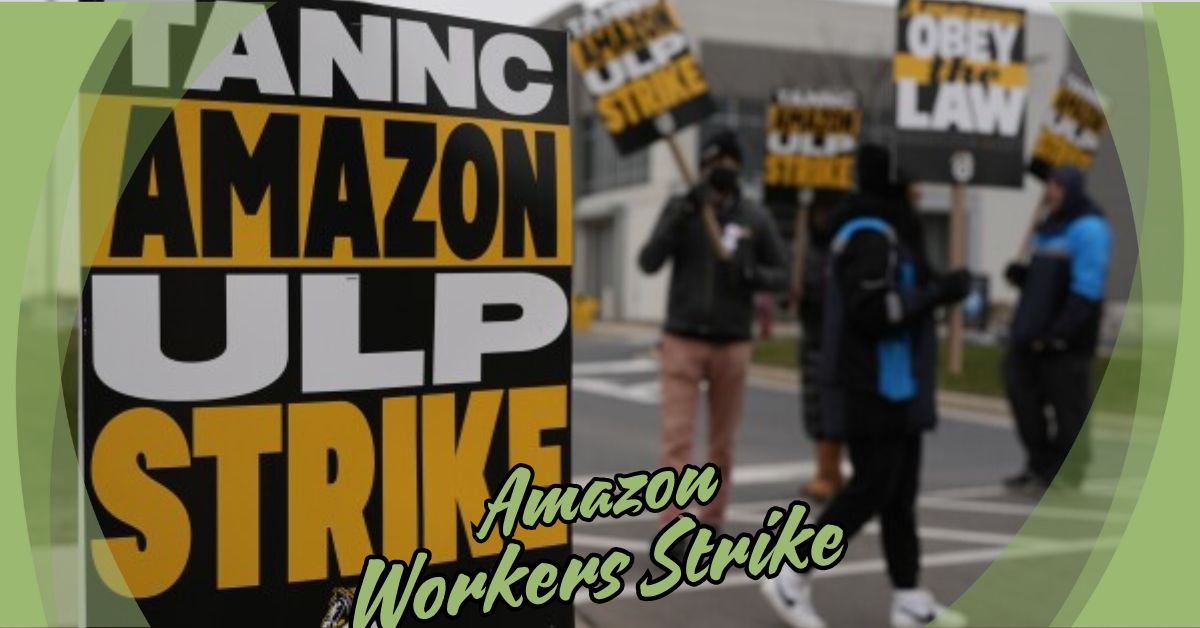In recent years, Amazon has become the center of various discussions related to worker rights, labor conditions, and pay disputes. One of the most significant and ongoing events in this area is the Amazon workers strike. This strike has sparked debates about the treatment of employees, the push for better working conditions, and the growing influence of labor unions in a company known for its fast-paced work environment. In this post, we will dive into the key factors behind the Amazon workers’ strike, its effects, and the demands of those involved.
What Led to the Amazon Workers Strike in 2024?
The Amazon workers strike of 2024 was the culmination of years of frustration from employees over various issues, including low wages, poor working conditions, and a lack of job security. Despite Amazon being one of the most successful e-commerce companies in the world, workers, especially in Amazon warehouses, have long raised concerns over the physical and mental toll of their work. As Amazon’s business continues to grow, many employees feel that their compensation and treatment have not kept pace with the company’s financial success.
In 2024, these concerns escalated, and workers took to the streets to demand changes. The primary triggers for this strike included demands for better pay, improved benefits, and safer working conditions. Many workers reported high levels of stress due to the intense performance metrics Amazon sets for its warehouse staff, leading to claims of unfair treatment and exploitation.
Key Reasons Behind the Amazon Worker Protest
The Amazon labor rights movement has been driven by several key factors. At the heart of the protest are concerns over wages. Despite Amazon’s vast profits, many workers feel that their compensation does not reflect their hard work and the demanding nature of the job. Many warehouse employees in particular have voiced frustration over wages that they consider insufficient for the amount of work required.
Working conditions have also been a significant issue. Amazon’s warehouses are often described as high-pressure environments where workers are expected to meet strict performance targets. There are reports of workers being constantly monitored, with little room for breaks or flexibility. The physical toll of such work, coupled with a lack of proper rest or medical support, has led to a growing demand for better treatment.
Another significant factor is the ongoing battle over unionization. Amazon workers unionization efforts have been a subject of intense debate, with many workers pushing for stronger representation and the right to organize for better conditions. However, Amazon has historically been resistant to unionization, which has fueled the anger and frustration of its employees.
How Does the Amazon Workers Strike Impact the Business?
The impact of the Amazon workers strike on the business has been significant. Strikes in key warehouses have led to delays in shipping, disruptions in supply chains, and a reduction in overall productivity. Amazon, known for its fast delivery times, was forced to reassess its operations in response to the strike, facing challenges to meet customer demands.
Furthermore, the Amazon strike has garnered significant media attention, shedding light on the company’s labor practices and forcing the public to question how its employees are treated. The strike has also raised awareness of the growing power of workers’ movements in large corporations. As a result, Amazon has had to reconsider its labor policies, especially as public pressure continues to mount.
The financial implications of the strike are also considerable. As Amazon continues to face backlash from customers and the general public, its reputation has taken a hit. In addition, supply chain disruptions can lead to a loss of revenue and customer loyalty. While Amazon remains a dominant force in the market, the strike has certainly impacted its image as a fair employer.
The Role of Labor Unions in Amazon Workers Strikes
The role of labor unions in the Amazon workers strike cannot be overstated. Over the years, unions have become more involved in advocating for Amazon workers, pushing for better wages, benefits, and workplace conditions. Many of the protests and strikes that have taken place in recent years have been fueled by union efforts to gain greater representation for Amazon workers.
Unions have played a critical role in organizing protests, rallying workers, and providing legal support for those involved in strikes. The involvement of unions has helped amplify the voices of workers, ensuring that their grievances are heard by the public, the media, and the company itself.
However, Amazon has historically fought against unionization efforts, with the company employing a variety of tactics to discourage workers from joining unions. This resistance has only fueled the frustration of employees, leading to more protests and strikes. As the debate over unionization continues, the role of labor unions in Amazon workers’ movements will remain a central point of contention.
What Are the Demands of Amazon Warehouse Workers?
The specific demands of Amazon warehouse workers during the strike have focused on several key issues. One of the primary concerns is better pay. Many workers argue that their compensation does not reflect the demanding nature of their work, especially considering Amazon’s substantial profits. They are calling for wage increases to align with the rising cost of living and the intense workload that comes with their roles.
Another major demand is improved benefits. Workers are asking for better healthcare coverage, paid sick leave, and other benefits that would provide them with greater security in their jobs. Many workers feel that Amazon has not done enough to support their health and well-being, particularly given the physically demanding nature of warehouse work.
Finally, workers are advocating for safer working conditions. Reports of injuries, unsafe equipment, and a lack of adequate rest time have prompted workers to demand better safety standards. In some cases, workers have claimed that they were penalized for taking necessary breaks or seeking medical attention for injuries sustained on the job. The push for improved safety measures is one of the key drivers of the ongoing strike.
Global Repercussions: Amazon Worker Strikes Around the World
The Amazon workers strike is not limited to the United States. Amazon operates in countries around the world, and labor disputes have occurred in multiple regions. In Europe, workers have protested against Amazon’s working conditions, with strikes occurring in countries like Germany and Spain. These protests often focus on issues such as pay, benefits, and working hours, and they are indicative of the growing global labor movement within Amazon.
In some countries, Amazon has faced significant backlash for its labor practices. For example, in the UK, workers have demanded better wages and conditions, with unions advocating for stronger protections for employees. The international nature of these strikes highlights the global scale of the issues at hand, and it has put pressure on Amazon to address labor concerns on a wider scale.
The Future of Amazon Worker Strikes: Will They Change the System?
As the Amazon workers strike continues, the future of these protests remains uncertain. Will Amazon ultimately change its labor practices in response to the growing movement, or will it continue to resist worker demands? The answer to this question largely depends on how the strike unfolds in the coming months.
Amazon’s response to the strike has been a mix of concessions and resistance. While the company has made some changes in response to worker demands, such as offering pay raises in certain regions, it has continued to resist unionization efforts. This ongoing tension between workers and management is likely to persist, and it may lead to further strikes in the future.
However, the strike has already had a significant impact on Amazon’s reputation and business operations. As more workers become involved in the protests, it is possible that Amazon will be forced to make more substantial changes to its labor policies. The future of Amazon’s labor relations will depend on how the company responds to the growing demand for change.
Amazon’s Response to the Workers’ Strike: What is the Company Doing?
In response to the Amazon workers strike, the company has made a number of attempts to address worker concerns. Some employees have received pay increases, and Amazon has promised to improve safety standards in its warehouses. Additionally, Amazon has made some concessions regarding job security and benefits for certain workers.
However, many critics argue that these efforts have not gone far enough. Workers continue to report issues with working conditions and compensation, and the strike has shown that Amazon’s responses have not fully resolved the underlying problems. As the strike continues, Amazon may be forced to reevaluate its approach to labor relations and make more substantial changes to address worker grievances.
Conclusion
The Amazon workers strike of 2024 has brought attention to important issues related to labor rights, pay, and working conditions. As Amazon workers continue to demand better treatment, the company faces pressure to address these concerns and improve its labor policies. While the strike has caused significant disruptions to Amazon’s operations, it has also sparked important conversations about worker rights in the modern workplace.
As the strike continues to unfold, it remains to be seen whether Amazon will make the necessary changes to satisfy its workers. However, the growing movement among employees, coupled with the involvement of unions and global protests, suggests that the conversation around labor rights at Amazon will continue for the foreseeable future.
FAQs
- What started the Amazon workers strike?
The Amazon workers strike began due to dissatisfaction with low wages, poor working conditions, and a lack of job security in Amazon warehouses. Workers also demanded better pay and benefits. - How many Amazon workers are involved in the strike?
The strike has involved thousands of Amazon workers across multiple countries, particularly in key warehouse locations. - What are Amazon workers demanding during the strike?
Amazon workers are demanding higher wages, improved benefits, safer working conditions, and more job security. - How will the Amazon workers strike affect delivery times?
The strike has caused delays in shipping and disruptions in Amazon’s supply chain, which could impact delivery times. - What are the legal implications of the Amazon workers strike?
The strike raises legal questions regarding unionization rights, labor laws, and workers’ ability to protest against their employer. - What can customers do to support Amazon workers during the strike?
Customers can support Amazon workers by backing their demands for fair wages, better conditions, and advocating for workers’ rights. - Will Amazon workers win better pay and benefits after the strike?
The outcome of the strike remains uncertain, but it is possible that Amazon will make concessions to address worker concerns in response to the ongoing protests.

Shazny plays a key role behind the scenes, reviewing and refining content before it goes live. With a strong eye for detail, Shazny ensures that every article meets high standards of clarity, accuracy, and trustworthiness. From grammar checks to fact verification, Shazny helps maintain the quality and credibility of everything published on TryHardGuides.
Discover more from Try Hard Guides
Subscribe to get the latest posts sent to your email.

